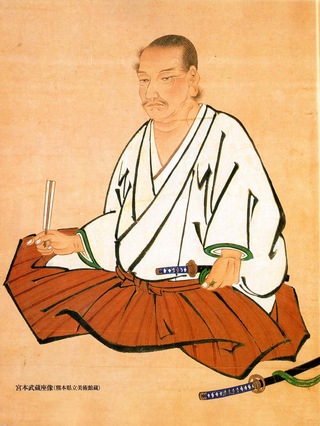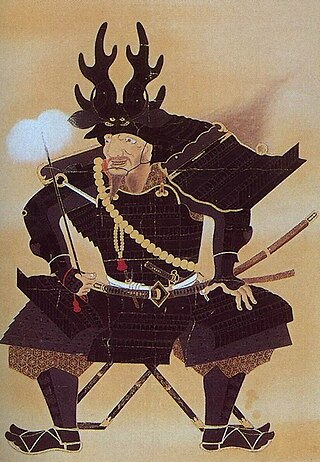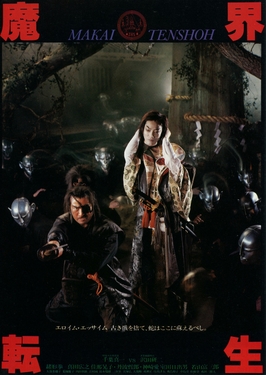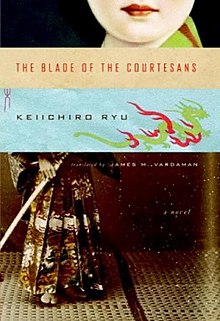
Miyamoto Musashi, born Shinmen Takezō, also known as Miyamoto Bennosuke and by his Buddhist name, Niten Dōraku, was a Japanese swordsman, strategist, artist, and writer who became renowned through stories of his unique double-bladed swordsmanship and undefeated record in his 62 duels. Musashi is considered a kensei of Japan. He was the founder of the Niten Ichi-ryū, or Nito Ichi-ryū, style of swordsmanship, and in his final years authored The Book of Five Rings and Dokkōdō.

Yagyū Munenori was a Japanese daimyo, swordsman, and martial arts writer, founder of the Edo branch of Yagyū Shinkage-ryū, which he learned from his father Yagyū "Sekishūsai" Muneyoshi. This was one of two official sword styles patronized by the Tokugawa shogunate. Munenori began his career in the Tokugawa administration as a hatamoto, a direct retainer of the Tokugawa house, and later had his income raised to 10,000 koku, making him a minor fudai daimyō, with landholdings around his ancestral village of Yagyū-zato. He also received the title of Tajima no Kami (但馬守).

Takuan Sōhō was a Japanese Buddhist prelate during the Sengoku and early Edo Periods of Japanese history. He was a major figure in the Rinzai school of Zen Buddhism. Noted for his calligraphy, poetry, tea ceremony, he is also popularly credited with the invention of the takuan pickled radish.
Yagyū Jūbē Mitsuyoshi was one of the most famous and romanticized of the samurai in Japan's feudal era.

A hatamoto was a high ranking samurai in the direct service of the Tokugawa shogunate of feudal Japan. While all three of the shogunates in Japanese history had official retainers, in the two preceding ones, they were referred to as gokenin. However, in the Edo period, hatamoto were the upper vassals of the Tokugawa house, and the gokenin were the lower vassals. There was no precise difference between the two in terms of income level, but a hatamoto had the right to an audience with the shogun, whereas gokenin did not. The word hatamoto literally means "origin/base of the flag", with the sense of 'around the flag', it is described in Japanese as 'those who guard the flag' and is often translated into English as "bannerman". Another term for the Edo-era hatamoto was jikisan hatamoto (直参旗本), sometimes rendered as "direct shogunal hatamoto", which serves to illustrate the difference between them and the preceding generation of hatamoto who served various lords.

Fudai daimyō (譜代大名) was a class of daimyō (大名) in the Tokugawa Shogunate (徳川幕府) of Japan who were hereditary vassals of the Tokugawa before the Battle of Sekigahara. Fudai daimyō and their descendants filled the ranks of the Tokugawa administration in opposition to the tozama daimyō and held most of the power in Japan during the Edo period.

The Yagyū were a family of daimyōs with lands just outside Nara, who became the heads of one of Japan's greatest schools of swordsmanship, Yagyū Shinkage-ryū. The Yagyū were also Kenjutsu teachers to the Tokugawa shōguns and descendant of the famous Taira clan, hailing from prestigious Imperial Lineage with the Kabane rank of Ason.
Yagyū Sekishūsai Taira-no-Munetoshi was a samurai in Japan's Sengoku period famous for mastering the Shinkage-ryū school of combat, and introducing it to the Tokugawa clan. He was also known as Shinsuke, or Shinzaemon.
This is a list of fictional depictions of Miyamoto Musashi, a 17th-century Japanese swordsman.

Yorozuya Kinnosuke (萬屋錦之介) was a Japanese kabuki actor. Born Kin'ichi Ogawa, son of kabuki actor Nakamura Tokizō III, he entered kabuki and became the first in the kabuki tradition to take the name Nakamura Kinnosuke. He took on his guild name (yagō) Yorozuya as his surname in 1971.

Samurai Reincarnation is a 1981 Japanese dark fantasy film written and directed by Kinji Fukasaku and starring Sonny Chiba, Kenji Sawada, and Hiroyuki Sanada. It is based on the novel of the same name by Futaro Yamada.

Ryu ga Gotoku Kenzan! is an action-adventure video game developed and published by Sega for the PlayStation 3. It is a jidaigeki-themed spin-off game in the Like a Dragon series. It was unveiled at the Tokyo Game Show 2007 and released exclusively in Japan on March 6, 2008.
Annaka Domain was a feudal domain under the Tokugawa shogunate of Edo period Japan, located in Kōzuke Province, Japan. It was centered on Annaka Castle in what is now the city of Annaka, Gunma.
Mikogami Tenzen (神子上典膳) or Ono Jiroemon Tadaaki was a Japanese samurai of the early Edo period, who was renowned as a swordsman. He founded the Ono-ha Ittō-ryū style of swordsmanship after his teacher made him head master of the Ittō-ryū. He was one of two official sword masters for Tokugawa Ieyasu and his style, along with Yagyū Shinkage-ryū became one of the official ryūha of the Tokugawa Shogunate.

The Yagyu Ninja Scrolls is a Japanese manga series by Masaki Segawa, an adaptation of a novel Yagyū Ninpōchō by Futaro Yamada. It was serialized in Kodansha's seinen manga magazine Weekly Young Magazine from May 2005 to June 2008, with its chapters collected in eleven tankōbon volumes. Like the author's previous title Basilisk, The Yagyu Ninja Scrolls is based on a novel from Yamada's Ninpōchō series and can therefore be considered a sequel to Basilisk, especially as several of the same historical characters featured in Basilisk make a return appearance. Its story centers on seven female survivors of the Hori clan, aided by Yagyū Jūbei, and their quest of vengeance.
The Edo period of the history of Japan is the setting of many works of popular culture. These include novels, stage plays, films, television shows, animated works, manga, and video games. Major events of the period, such as the Siege of Osaka, Shimabara Rebellion, and the decline and fall of the Tokugawa shogunate figure prominently in many works. Historical and fictional people and groups of the period, including Miyamoto Musashi, Izumo no Okuni, Yagyū Jūbei Mitsuyoshi, the fictional Isshin Tasuke, Yui Shōsetsu, Matsuo Bashō, Tokugawa Mitsukuni, Ōoka Tadasuke, Tōyama Kagemoto, the Forty-seven Ronin, Sakamoto Ryōma, Katsu Kaishū, and the Shinsengumi, as well as the fifteen Tokugawa shoguns were active for much or all of their public lives and are dramatized in works of popular culture. The cultural developments of the times, including kabuki, bunraku, and ukiyo-e, and practices like sankin kōtai and pilgrimages to the Ise Shrine, feature in many works set in Edo Japan.

Hyakka Ryōran: Samurai Girls is a Japanese light novel series written by Akira Suzuki with illustrations by Niθ to commemorate Hobby Japan's 40th anniversary. The first volume was released by Hobby Japan on February 28, 2009, with 17 volumes currently available in Japan under their HJ Bunko imprint. There are currently three different manga adaptations based on the Hyakka Ryoran universe published. An online anthology comic was serialized on Hobby Japan's media website Hobby Channel from June 1, 2010, and sold two volumes as of June 2011; a manga adaptation illustrated by Junichi Iwasaki began serialization in the November 2010 issue of Monthly Comic Alive; and another manga adaptation by Tatara Yano began serialization in Hobby Japan's online manga magazine Comic Dangan on December 23, 2011. A spinoff manga called Hyakka Ryōran: Sengoku Maidens, illustrated by Yuri Shinano, was serialized in the March 2009 issue of Dengeki Daioh and ended in the March 2011 issue, and released three volumes as of March 2012.
Matsudaira Tadayori was a Sengoku period samurai who became a daimyō under the Tokugawa shogunate in early-Edo period Japan. He was also the founder of the Sakurai-branch of the Matsudaira clan.
Tokugawa Buraichō (徳川無頼帳) is a Japanese jidaigeki or period drama, that was broadcast in 1992.
The Order of Musashi Shinobi Samurai is a Japanese shinobisamurai clan which served Tokugawa Ieyasu and the Edo Shogunate from 1582 to 1868. They served the Tokugawa Shogunate as intelligence operatives called onmitsu, and metsuke (inspectors), and in the 19th century, as diplomats. When the political system changed due to the restoration of the monarchy in 1868, it became independent. The order consists of a number of families and people who have built close relations of trust with the Shibata Clan of the Musashi Province.











